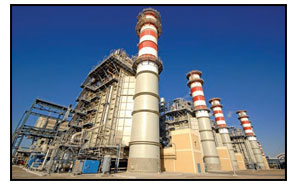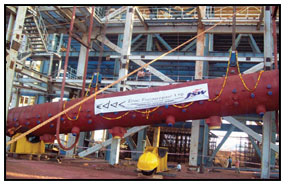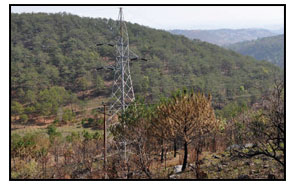 — Ashok Khurana, Director-General,
Association of Power Producers
— Ashok Khurana, Director-General,
Association of Power Producers
The Association of Power Producers is a representative body of
private power developers in the country with nearly over 1 lakh mw
of power projects under various stages of development in its
membership. APP has been formed with the objective of becoming
a forum where developers debate changes in the policy and
regulatory environment, which impact the sector. In an exclusive
interaction,
Ashok Khurana talks at length about the association
and gives insights into several critical issues affecting the power
sector. An interview by
Venugopal Pillai.
To begin with, please tell us about the key objectives of APP.
The key objectives of APP are as follows:
- APP is an endeavor to aid and influence formulation of policies
for supply of quality and affordable power to all
- APP compliments official initiatives by exploring policy
alternatives. It provides informal and valuable inputs for
informed decision making
- To provide a forum for addressing generic issues impacting
private sector investment in the power sector
- To help evolve long term strategies for a competitive power
market in India
An increasing number of private power producers are placing
BTG orders on Chinese suppliers. This is also seen by some to be
going against national ideologies. What is your overall reaction
to this phenomenon?
As against the original target of 78,700 mw the XI Plan, the country
has been able to achieve a capacity addition of 54,000 mw as of up
to December 2011. A significant portion (28,280 mw) of this actual
augmentation has been contributed by the private sector. This
level of unprecedented participation has been encouraged by the
principles of the Mega Power Policy and competitive tariff-based
bidding which have given freedom for developers to source inputs
for projects in the most efficient and cost-effective manner.
Keeping the domestic manufacturing constraints in mind, import
of equipment for power projects has been a major contributor in the
capacity addition in the current Five Year Plan Period with almost 50
per cent of the coal based capacities based on imported equipment.
This trend is likely to continue in the next plan period also as the
domestic equipment manufacturers are already overburdened with
existing orders and thus not in a position the meet the demand of the
domestic power project developers leading to an overall delay and
significant cost over-runs affecting the projects.
At the end, I would like to emphasize that there are no national
ideologies in an international competitive market. Our experience
has shown that imported equipment have shorter supply timelines
leading to cost savings on interest during construction and also
bring the advantage of foreign funding at a time when domestic
sources of funds are under pressure regarding their exposure to
the power sector. In a competitive market the developer should
source the equipment on merit, keeping in mind the derived cost
efficiency after taking care of quality of the equipment.
 Acquisition of land and securing of environmental clearances have
always known to hinder the pace of power project implementation.
What is your overall view? Do you see matters improving of late?
Acquisition of land and securing of environmental clearances have
always known to hinder the pace of power project implementation.
What is your overall view? Do you see matters improving of late?
Land acquisition, R&R issues and delay in issuance of necessary
environment and forest clearances are the biggest hurdles in
timely development of power projects as well as coal mining on
account of interactions involved with multiple agencies and
government bodies at the state and central level. In addition, two
critical issues related to related to environment and forests have
affected power project implementation in the recent past —
determination of 'go' and 'no-go' areas for coal mining and
secondly, recent MoEF circulars which have stated that only
those proposals related to thermal power plants would be
considered for Environmental Clearance for which the coal
linkage is available and the status of the environment and
forestry clearance of the linked coal mine/block is known, and
environmental clearance for coal mines will be provided only
after forest clearance is obtained.
While the 'go/no-go' policy is being scrapped by the
government, the latter issue regarding the MoEF circulars still
needs to be resolved as due to this, the implementation time of the
projects is increasing due to sequential processing of the
clearances instead of the earlier practice of parallel processing of
the clearances.
Regarding land acquisition, the draft Land Acquisition and
Rehabilitation & Resettlement Act, 2011 has been tabled in the Lok
Sabha. While the Act has incorporated many positive features
related to adequate compensation and rehabilitation and
resettlement entitlements to project affected people, issues like
timely land acquisition as a necessary prelude to ensuring timely
project execution and proper sequencing of events in the lead up
to land acquisition need to be settled. We eagerly look forward to
the support of the Standing Parliamentary Committee in the
matter. It is also understood that Chief Ministers of States are also
addressing to their respective stakeholder concerns before taking
up the matter with the Union Government.
Coal linkages have been very difficult to come by recently—not
only for new projects but also for ongoing power plants. What do
you think could be done at the policy level to ensure that sufficient
coal is available for upcoming and ongoing power plants?
Plants based on domestic coal are facing issues related to
coal availability and consequent pricing issues if they resort
to alternate means to source coal. The New Coal Distribution
Policy, as issued by the Ministry of Coal in 2007, mandates a
firm commitment on the part of Coal India Ltd (CIL) to supply
100 per cent of the normative coal requirement of the power
producers. FSAs (Fuel Supply Agreements) under the NCDP
are supposed to provide for an Annual Contracted Quantity
(ACQ) equal to the normative coal requirement of the power
plant. However, in practice, substantial reductions to the
ACQ are being dictated by CIL at the time of execution of the
FSAs. Purchasers of coal from CIL are being asked to sign a
MoU which says that supply of coal shall be at the sole
discretion of CIL and that supply of indigenous coal shall at
best be 50 per cent of the ACQ. CIL has further reduced the
trigger for paying compensation to purchasers by half of
what is provided under the FSA. The trigger to pay
compensation has been brought down to 25 per cent of the
ACQ. Thus, CIL practically refuses to take any responsibility
even with respect to the unilaterally reduced Annual
Contracted Quantity under the FSA (which itself is lower than
the normative coal requirement).
APP has suggested to the Planning Commission and Ministry of
Coal to constitute a working group comprising of representatives
from MoC, MoP, CIL, APP, Financial Institutions and leading power
developers to draft a model Fuel Supply Agreement taking care of
the interest of all stakeholders. It will need to be ensured that such
a model FSA will be signed by Coal India Ltd with project
developers. Regarding the approximately 22,000 mw worth of
installed capacity that has not been able to get FSAs since March
2009, the following two measures have been suggested:
- Diversion of 50 per cent of e-auction coal to the power sector
- Reducing normative quantity to be supplied under existing FSAs
by 10 per cent
The above two measures are likely to increase coal supply
under linkages for the projects commissioned after March 2009 by
around 50 million tonnes, leaving 10-15 million tonnes to be
bridged through imports.
For the long term however steps for augmenting domestic
production is essential and APP has made the following
suggestions in various representations:
- Improving Coal India production efficiency through the use of
MDO (Mine Developer and Operator)
- Introducing competition in coal sector by auctioning coal blocks
to private coal mining companies
- Accelerating Captive coal production through appropriate
pricing policy on surplus production
- Expediting environmental clearances for coal projects
We hear of private power producers finding it difficult to attain
financial closure for their projects in the absence of coal
linkages. Coal India, on the other hand, insists on financial
closure as a precondition to assigning coal linkages. What is your
view on this paradoxical situation and what is your general
perception of the growing exposure of banks and lending
institutions to the power sector?
Current linkages given by the Standing Committee on Coal
Linkages (SLC) are subject to key milestones being achieved by
the project developer, including financial closure within three
months from the date of Letter of Assurance (LOA). Regarding
the exposure of financial institutions, banking sector exposure
to the power sector has touched a high of Rs.292,342 crore. It is
estimated that up to 38,750 mw of installed generation capacity
is facing fuel issues such as domestic coal and gas shortage,
high price of imported coal and captive mines delayed due to
clearance issues. Assuming a capital cost of Rs.5 crore per mw
and a debt-equity mix of 70:30, the total aggregate amount of
default to the banking sector could be Rs.135,618 crore, which
is 46.39 per cent of the current banking exposure to the power
sector. Such large NPAs will have serious repercussions for
future capacity addition and financing for power sector
projects. Thus it is imperative to resolve the issues faced by the
generation sector without any delay.
In this regard we are pleased to note that a Committee of
Secretaries has been constituted under the Principal Secretary
Pulok Chatterji for addressing the power sector woes and we look
forward to successful resolution of the above issues.
 We understand that tariff-based competitive bidding has brought
about a gradual reduction in tariffs, which is ultimately in the
benefit of the consumer. How do you rate the overall success of
tariff-based competitive bidding (both Case I and Case 2) so far?
We understand that tariff-based competitive bidding has brought
about a gradual reduction in tariffs, which is ultimately in the
benefit of the consumer. How do you rate the overall success of
tariff-based competitive bidding (both Case I and Case 2) so far?
Since the notification of the Competitive Bidding Guidelines (CBG)
in 2005, more than 44,800 mw of generation capacity have been
awarded with more than 30 cases of Case 1 and Case 2 bidding
conducted successfully. This framework has not only resulted in
providing a strong platform for increased private sector
participation in the power generation segment but has also
resulted in considerably lower tariff discoveries, particularly in
comparison to the traditional cost plus regime. As per analysis
undertaken by the CERC in September 2010, there existed a
differential of Rs.0.23 per unit (kwh) on a weighted average basis
between the levelized tariff as per bidding and computed levelized
tariff under cost-plus basis over 14 plants for which the analysis
was undertaken.
However, over the last five years or so, several issues have
emerged which have necessitated a re-look at the bidding
mechanisms. A specter of acute coal shortage looms large on the
sector, with a severe risk of stranding of assets and consequential
defaults in the associated contracts. Imported coal has seen
tremendous volatility due to changing demand scenarios from
China and India. Even as Indian developers have sought to hedge
risks through acquisition of overseas mines, changes in laws in the
source countries have altered the pricing framework. The
situation is expected to worsen in the short and medium term as
more capacity is commissioned creating greater imbalance in the
fuel supply demand scenario. Urgent steps are required in order to
address the above issues.
With uncertainties in coal supplies and also a sharp increase in
imported coal prices , many private producers may find it difficult
to honour the tariffs quoted whilst winning projects under the
competitive bidding guidelines. What is your take?
The conditions and premises under which the standard bidding
documents were prepared have changed radically since they were
first introduced. Recently announced regulations pursuant to the
new mining law in Indonesia do not allow coal exporting
companies to sell coal at prices lower than Reference Prices.
Similarly, Australia has also recently introduced a draft law that
plans to levy taxes to generate additional revenue from exports of
coal and iron ore. This is expected to be effective from July 2012.
There is also possibility of introduction of carbon tax on
Australian coal production. After implantation of these laws,
Australian coal prices are expected to go up by $20-25 per tonne.
Other coal exporting countries may also follow suit. Hence power
projects based on imported coal are unable to import coal on fixed
price and fixed escalation structure envisaged at the time of
bidding as all existing long term contracts are to be brought in
conformity with the new regulations.
Plants based on domestic coal have also been impacted due to
the domestic coal shortages, thus forcing them to buy imported coal at much higher prices. Thus, urgent action needs to be taken
to address the issues being faced in the existing contracts. The
above trends also have serious implications for not only the power
sector but also the associated sector particularly the equipment
supply sector (where major investments have been made) and the
banking sector that is already facing huge exposure to power
sector projects.
With the Union power ministry now making it mandatory for all
power purchases (effective January 5, 2011) to be made using the
tariff-based competitive bidding route, what happens to several
power projects for which MoUs have been signed earlier?
Any action taken regarding signing of MoUs prior to January 5,
2011 is in consonance with the Law and Tariff Policy provided
there is no intention of cornering the market and foreclosing
options for competitive bidding for power, as in the case of NTPC
signing MoUs of more than 75000 mw right before the January 5
2011 deadline, for which APP has already approached CERC.
What is your view on the overall progress on the ultra mega power
project series? We understand that three out of the four projects
awarded have gone to a single developer. Does this increase the
risk of the project, in a macro sense?
The Ministry of Power had launched an initiative for
development of coal-based super critical UMPPs each of about
4,000 mw capacity under Case II bidding route. Four UMPPs—
Sasan in Madhya Pradesh, Mundra in Gujarat, Krishnapatnam
in Andhra Pradesh and Tilaiya in Jharkhand—have already
been transferred to the identified developers and are at
different stages of implementation.
Sasan, Krishnapatnam and Tilaiya have gone to Reliance
Power while Mundra has gone to Tata Power. One unit of 800
mw of the Mundra UMPP is being commissioned and the
second is expected to be commissioned by 2012. However,
the main issue arising with the UMPPs is not the concern
about how many projects have gone to a single developer but
the fact that a basic requirement of the project-coal-is under
threat due to volatile market conditions. UMPPs based on
imported coal are deeply concerned because the existing
contract provisions do not address some of the key risks
associated with the imported coal.
Another major point of concern pertaining to the UMPP projects
is related to the pre-construction activities. The Standard Bidding
Documents require the procurers (states buying the power from
the UMPP) to ensure that the preparatory activities related to (a)
site identification and land acquisition (b) environmental
clearance (c) forest clearance (d) fuel arrangements and (e) water
linkages are completed simultaneously with the bid process.
However it has been notice that in most cases the above
activities continue much beyond the issuance of the LoI with the
responsibilities transferred to the developer after the bidding
process. Such transfer of responsibility hinders smooth project
development and results in delays to the execution timelines.
APP's suggestion is that such crucial project preparatory activities
should be a part of the 'conditions precedent' to be fulfilled by the
procurer(s) before issuance of LoI.
 How much power capacity is currently under execution by APP
members?
How much power capacity is currently under execution by APP
members?
APP currently represents more than 90 per cent of the power
capacities being put up by independent power producers (IPPs)
and has a combined portfolio of 120,000 mw.
By the end of the XII Plan period, how much of India's power
generation capacity do you think would be in the private sector?
As of December 2011, out of a total installed capacity of
186,655 mw the private sector's share in installed generation
capacity is around 45,300 mw. The XII Plan envisages a total
capacity addition of 75,785 mw out of which the private sector
is expected to contribute around 42,100 mw. Therefore, by the
end of the XII Plan the private sector is expected to have an
installed capacity of around 88,000 mw out of a total of around
266,000 mw, which represents a share of around 33 per cent.
If you were to cite three most important items of APP's current
agenda, what would they be?
I would say:
- Fuel shortage (coal and gas) and dispensing with priority in
allocation to public sector
- Competitive Bidding - advocating framework for all
generation companies irrespective of ownership for a level
playing field and equitable allocation of risk (fuel, land etc)
to all
- Compatibility between fuel (coal/gas) allocation framework
with power sector regulatory regime and feasibility of large
scale coal imports